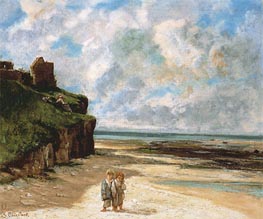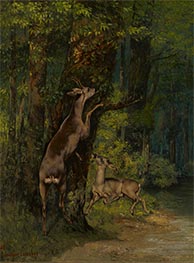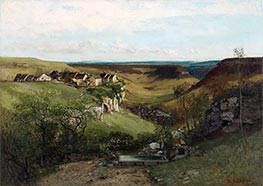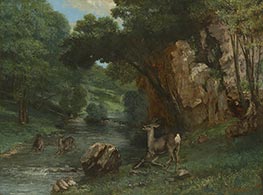
Gustave Courbet Painting Reproductions 1 of 1
1819-1877
French Realist Painter
Jean Desire Gustave Courbet (June 10, 1819 - December 31, 1877) was a French painter who led the Realist movement in 19th-century French painting.
Realism
Best known as an innovator in Realism (and credited with coining the term), Courbet was a painter of figurative compositions, landscapes and seascapes. His work belonged neither to the predominant Romantic nor Neoclassical schools. Rather, Courbet believed the Realist artist's mission was the pursuit of truth, which would help erase social contradictions and imbalances.
For Courbet realism dealt not with the perfection of line and form, but entailed spontaneous and rough handling of paint, suggesting direct observation by the artist while portraying the irregularities in nature. He depicted the harshness in life, and in so doing, challenged contemporary academic ideas of art, which brought the criticism that he deliberately adopted a cult of ugliness.
His work, along with the works of Honore Daumier and Jean-Francois Millet, became known as Realism.
Born in Ornans (Doubs), into a prosperous farming family which wanted him to study law, he went to Paris in 1839, and worked at the studio of Steuben and Hesse. An independent spirit, he soon left, preferring to develop his own style by studying Spanish, Flemish and French painters and painting copies of their work.
His first works were an Odalisque, suggested by the writing of Victor Hugo, and a Lelia, illustrating George Sand, but he soon abandoned literary influences for the study of real life.
A trip to the Netherlands in 1847 strengthened Courbet's belief that painters should portray the life around them, as Rembrandt, Hals, and the other Dutch masters had done.
Among his early works, he painted his own portrait with his dog, and The Man with a Pipe, both of which the Paris Salon jury rejected. However, the younger critics, the Neo-romantics and Realists, loudly sang his praises, and by 1849 Courbet was becoming well known, producing such pictures as After Dinner at Ornans (for which the Salon awarded him a medal) and The Valley of the Loire.
Burial at Ornans
One of Courbet's most important works is Burial at Ornans, a canvas recording an event which he witnessed in September of 1848. Courbet's painting of the funeral of his grand uncle became the first masterpiece in the Realist style. People who had attended the funeral were used as models for the painting. Previously, models had been used as actors in historical narratives; here Courbet said that he "painted the very people who had been present at the interment, all the townspeople". The result is a realistic presentation of them, and of life, in Ornans. The painting caused a fuss with critics and the public. It is an enormous work, measuring 10 by 22 feet, and depicts a prosaic ritual on a scale which previously would have been reserved for a religious or royal subject. Eventually the public grew more interested in the new Realist approach, and the lavish, decadent fantasy of Romanticism lost popularity. The artist well understood the importance of this painting; as Courbet said, "the Burial at Ornans was in reality the burial of Romanticism."
The Salon of 1850 found him triumphant with the Burial at Ornans, the Stone-Breakers (destroyed in 1945) and the Peasants of Flagey. Other figurative works, with common folk and friends as his subjects, included Village Damsels (1852), the Wrestlers, Bathers, and A Girl Spinning (1852).
Courbet associated his ideas of realism in art with Socialism, and having gained an audience he promoted democratic and Socialist ideas by writing politically motivated essays and dissertations.
To a friend in 1850 he wrote, "...in our so very civilized society it is necessary for me to live the life of a savage. I must be free even of governments. The people have my sympathies, I must address myself to them directly."
He displayed his monumental The Artist's Studio in 1855. It is an allegory of his life as a painter, seen as a heroic venture, in which he is surrounded by friends and admirers, among them Charles Baudelaire.
Notoriety
Towards the end of the 1860s, Courbet painted a series of increasingly erotic works, culminating in The Origin of the World (L'Origine du monde) (1866), depicting female genitalia, and The Sleepers (1866), featuring two women in bed. While banned from public display, the works only served to increase his notoriety.
On April 14, 1870, Courbet established a "Federation of Artists" (Federation des artistes) for the free and uncensored expansion of art. The group's members included Andre Gill, Honore Daumier, Jean-Baptiste Camille Corot, Eugene Pottier, Jules Dalou, and Edouard Manet.
His refusal of the cross of the Legion of Honour offered to him by Napoleon III made him immensely popular with those who opposed the current regime, and in 1871 under the revolutionary Paris Commune he was placed in charge of all the Paris art museums and saved them from looting mobs. For his insistence in executing the Communal decree for the destruction of the Vendome Column, he was designated as responsible for the act and accordingly sentenced by a Versailles courtmartial to six months in prison and a fine of 500 francs. (September 2, 1871). In 1873 the newly elected president Mac-Mahon wanted to resurrect the Column and Courbet was singled out to pay the expenses. He then took refuge in Switzerland to avoid bankruptcy. On May 4, 1877 the estimate of the costs was finallly established: 323.091 fr 68 cent. Courbet was allowed to pay in yearly instalments of 10.000 francs for the next 33 years, until his 91st birthday.
Courbet died, age 58, at La Tour du Peilz, Switzerland, of a liver disease aggravated by heavy drinking on December 31, 1877, a day before the payment of the first installment was due. (Bernard Noel, 1978)
An exhibition of his works was held in 1882 at the Ecole des Beaux-Arts.
Realism
Best known as an innovator in Realism (and credited with coining the term), Courbet was a painter of figurative compositions, landscapes and seascapes. His work belonged neither to the predominant Romantic nor Neoclassical schools. Rather, Courbet believed the Realist artist's mission was the pursuit of truth, which would help erase social contradictions and imbalances.
For Courbet realism dealt not with the perfection of line and form, but entailed spontaneous and rough handling of paint, suggesting direct observation by the artist while portraying the irregularities in nature. He depicted the harshness in life, and in so doing, challenged contemporary academic ideas of art, which brought the criticism that he deliberately adopted a cult of ugliness.
His work, along with the works of Honore Daumier and Jean-Francois Millet, became known as Realism.
Born in Ornans (Doubs), into a prosperous farming family which wanted him to study law, he went to Paris in 1839, and worked at the studio of Steuben and Hesse. An independent spirit, he soon left, preferring to develop his own style by studying Spanish, Flemish and French painters and painting copies of their work.
His first works were an Odalisque, suggested by the writing of Victor Hugo, and a Lelia, illustrating George Sand, but he soon abandoned literary influences for the study of real life.
A trip to the Netherlands in 1847 strengthened Courbet's belief that painters should portray the life around them, as Rembrandt, Hals, and the other Dutch masters had done.
Among his early works, he painted his own portrait with his dog, and The Man with a Pipe, both of which the Paris Salon jury rejected. However, the younger critics, the Neo-romantics and Realists, loudly sang his praises, and by 1849 Courbet was becoming well known, producing such pictures as After Dinner at Ornans (for which the Salon awarded him a medal) and The Valley of the Loire.
Burial at Ornans
One of Courbet's most important works is Burial at Ornans, a canvas recording an event which he witnessed in September of 1848. Courbet's painting of the funeral of his grand uncle became the first masterpiece in the Realist style. People who had attended the funeral were used as models for the painting. Previously, models had been used as actors in historical narratives; here Courbet said that he "painted the very people who had been present at the interment, all the townspeople". The result is a realistic presentation of them, and of life, in Ornans. The painting caused a fuss with critics and the public. It is an enormous work, measuring 10 by 22 feet, and depicts a prosaic ritual on a scale which previously would have been reserved for a religious or royal subject. Eventually the public grew more interested in the new Realist approach, and the lavish, decadent fantasy of Romanticism lost popularity. The artist well understood the importance of this painting; as Courbet said, "the Burial at Ornans was in reality the burial of Romanticism."
The Salon of 1850 found him triumphant with the Burial at Ornans, the Stone-Breakers (destroyed in 1945) and the Peasants of Flagey. Other figurative works, with common folk and friends as his subjects, included Village Damsels (1852), the Wrestlers, Bathers, and A Girl Spinning (1852).
Courbet associated his ideas of realism in art with Socialism, and having gained an audience he promoted democratic and Socialist ideas by writing politically motivated essays and dissertations.
To a friend in 1850 he wrote, "...in our so very civilized society it is necessary for me to live the life of a savage. I must be free even of governments. The people have my sympathies, I must address myself to them directly."
He displayed his monumental The Artist's Studio in 1855. It is an allegory of his life as a painter, seen as a heroic venture, in which he is surrounded by friends and admirers, among them Charles Baudelaire.
Notoriety
Towards the end of the 1860s, Courbet painted a series of increasingly erotic works, culminating in The Origin of the World (L'Origine du monde) (1866), depicting female genitalia, and The Sleepers (1866), featuring two women in bed. While banned from public display, the works only served to increase his notoriety.
On April 14, 1870, Courbet established a "Federation of Artists" (Federation des artistes) for the free and uncensored expansion of art. The group's members included Andre Gill, Honore Daumier, Jean-Baptiste Camille Corot, Eugene Pottier, Jules Dalou, and Edouard Manet.
His refusal of the cross of the Legion of Honour offered to him by Napoleon III made him immensely popular with those who opposed the current regime, and in 1871 under the revolutionary Paris Commune he was placed in charge of all the Paris art museums and saved them from looting mobs. For his insistence in executing the Communal decree for the destruction of the Vendome Column, he was designated as responsible for the act and accordingly sentenced by a Versailles courtmartial to six months in prison and a fine of 500 francs. (September 2, 1871). In 1873 the newly elected president Mac-Mahon wanted to resurrect the Column and Courbet was singled out to pay the expenses. He then took refuge in Switzerland to avoid bankruptcy. On May 4, 1877 the estimate of the costs was finallly established: 323.091 fr 68 cent. Courbet was allowed to pay in yearly instalments of 10.000 francs for the next 33 years, until his 91st birthday.
Courbet died, age 58, at La Tour du Peilz, Switzerland, of a liver disease aggravated by heavy drinking on December 31, 1877, a day before the payment of the first installment was due. (Bernard Noel, 1978)
An exhibition of his works was held in 1882 at the Ecole des Beaux-Arts.
6 Courbet Paintings

The Beach at Saint-Aubin-sur-Mer 1867
Oil Painting
$624
$624
Canvas Print
$63.69
$63.69
SKU: COG-5679
Gustave Courbet
Original Size: 54 x 65 cm
Thyssen-Bornemisza Museum, Madrid, Spain
Gustave Courbet
Original Size: 54 x 65 cm
Thyssen-Bornemisza Museum, Madrid, Spain

The Water Stream, La Breme 1866
Oil Painting
$734
$734
Canvas Print
$59.24
$59.24
SKU: COG-5680
Gustave Courbet
Original Size: 114 x 89 cm
Thyssen-Bornemisza Museum, Madrid, Spain
Gustave Courbet
Original Size: 114 x 89 cm
Thyssen-Bornemisza Museum, Madrid, Spain

Deer in the Forest 1868
Oil Painting
$1160
$1160
Canvas Print
$56.46
$56.46
SKU: COG-17613
Gustave Courbet
Original Size: 130.8 x 97.8 cm
Minneapolis Institute of Arts, Minnesota, USA
Gustave Courbet
Original Size: 130.8 x 97.8 cm
Minneapolis Institute of Arts, Minnesota, USA

Château d’Ornans 1855
Oil Painting
$923
$923
Canvas Print
$53.96
$53.96
SKU: COG-17614
Gustave Courbet
Original Size: 81.6 x 116.8 cm
Minneapolis Institute of Arts, Minnesota, USA
Gustave Courbet
Original Size: 81.6 x 116.8 cm
Minneapolis Institute of Arts, Minnesota, USA

Roe Deer at a Stream 1868
Oil Painting
$993
$993
Canvas Print
$56.87
$56.87
SKU: COG-17692
Gustave Courbet
Original Size: 97.5 x 129.8 cm
Kimbell Art Museum, Fort Worth, USA
Gustave Courbet
Original Size: 97.5 x 129.8 cm
Kimbell Art Museum, Fort Worth, USA

The Gust of Wind c.1865
Oil Painting
$971
$971
Canvas Print
$50.46
$50.46
SKU: COG-19592
Gustave Courbet
Original Size: 146.7 x 230.8 cm
Museum of Fine Arts, Houston, USA
Gustave Courbet
Original Size: 146.7 x 230.8 cm
Museum of Fine Arts, Houston, USA